It looks like you're using an Ad Blocker.
Please white-list or disable AboveTopSecret.com in your ad-blocking tool.
Thank you.
Some features of ATS will be disabled while you continue to use an ad-blocker.
share:
reply to post by JadeStar
Absolutely fascinating posts. Thanks for your contribution. Looking forward to reading more!
Absolutely fascinating posts. Thanks for your contribution. Looking forward to reading more!
JadeStar
If a mod can let me know its ok to post this as its own new thread I will
You have a private message. Upper right corner you'll see buttons for Facebook, Twitter, YouTube, etc. You'll also see an envelope. Inside that envelope are your private messages, and when it's lit up, you have new ones.
To stray off the topic for just a moment-- It was indicated in a recent post that Nicola Tesla was the inventor of the superheterodyne radio receiver,
a radio technology staple of the 20th century. In fact, is was Edwin Howard Armstrong who invented this system, as well as the frequency modulation
(FM) system for both transmitters and receivers.
I found interesting the speculation about reports of small-statured extraterrestrials. It was suggested that this could signify their origin on large, 'super-Earth' planets. With stronger gravity than we have on Earth, such planets might well produce relatively short humanoids, but with comparatively stout or sturdy physiques. A problem here is that most of the short ETs are said to be gracile, thin, or lightly constructed. This would suggest their origin on worlds with less than terrestrial gravity.
There are several other possible explanations for short stature. These range from natural adaptation to a particular environment, possibly one with environmental limitations, to genetic engineering for some unknown purpose.
As small, red M class stars have become recognized as promising abodes for life, we might consider these in this context. As quite small stars, they seem likely to produce, on average, relatively small planets, with comparatively weak gravity.
We also have numerous descriptions of extraterrestrials with conspicuously large eyes. These could be a good adaptation to the limited, long wavelength light on a tidally locked planet of a red dwarf star.
It seems probable that the most temperate environments on such planets would be in twilight, in a band midway between the the brightest and darkest points on the planet. These, in a planet that keeps the same side facing the sun at all times, are permanently fixed points on the planet's surface.
I found interesting the speculation about reports of small-statured extraterrestrials. It was suggested that this could signify their origin on large, 'super-Earth' planets. With stronger gravity than we have on Earth, such planets might well produce relatively short humanoids, but with comparatively stout or sturdy physiques. A problem here is that most of the short ETs are said to be gracile, thin, or lightly constructed. This would suggest their origin on worlds with less than terrestrial gravity.
There are several other possible explanations for short stature. These range from natural adaptation to a particular environment, possibly one with environmental limitations, to genetic engineering for some unknown purpose.
As small, red M class stars have become recognized as promising abodes for life, we might consider these in this context. As quite small stars, they seem likely to produce, on average, relatively small planets, with comparatively weak gravity.
We also have numerous descriptions of extraterrestrials with conspicuously large eyes. These could be a good adaptation to the limited, long wavelength light on a tidally locked planet of a red dwarf star.
It seems probable that the most temperate environments on such planets would be in twilight, in a band midway between the the brightest and darkest points on the planet. These, in a planet that keeps the same side facing the sun at all times, are permanently fixed points on the planet's surface.
JadeStar
As you can see habitable planets larger than the Earth but smaller than the large planets of our own solar system seem to be more plentiful than planets like the Earth.
You must take into account that larger planets are far easier to detect than small ones. I speculate that for every super sized terrestrial there must be many more regular sized and smaller ones.
Yes, and past experience has shown that smaller objects tend to outnumber larger ones in the universe. It is not unreasonable to suspect that
comparatively small planets may be in the majority. Once we've done enough observing, and used good enough technology, the biases toward larger
planets may be overcome.
edit on 26-10-2013 by Ross 54 because: improved clarity
edit on 26-10-2013 by Ross 54 because:
improved syntax
Ross 54
A problem here is that most of the short ETs are said to be gracile, thin, or lightly constructed. This would suggest their origin on worlds with less than terrestrial gravity.
As small, red M class stars have become recognized as promising abodes for life, we might consider these in this context. As quite small stars, they seem likely to produce, on average, relatively small planets, with comparatively weak gravity.
We also have numerous descriptions of extraterrestrials with conspicuously large eyes. These could be a good adaptation to the limited, long wavelength light on a tidally locked planet of a red dwarf star.
I could not agree more. And if it is true that the greys come from such a world, I bet they hate that on Earth they are so heavy and the Sun is so bright. I bet their skin would sunburn like a redhead's.
Here is a 3d view based on the Hill map. It is from around 70 ly in the direction of Gliese 59.1

It seems that about 1/3 of the stars aren't quite where they should be; so there's probably some misidentification here.
It also appears that part of the original map is rotated around 90 degrees; Gliese 59.1, Tau(1) Eridani, and Ka. Fornacis.
And of course Zeta 1 and 2 appear as nearly the same star in this view.
Its kind of interesting; all but 2 or 3 are "G" class stars, all are over 3 billion years, typically less than 6 billion.
This image is taken from a 3D model of the stars built with Poser Pro(09). X, Y, Z coordinates computed from values in isbn star database using custom software (source available).
Sources:
star data: www.astrostudio.org...
Star positions: ISBN star database (this is a star catalog that seems current and reasonabley extensive that was in the right format for importing into SQL Server. Although it is composed of many tables and requires a bit of skill in the "SQL" language.)

It seems that about 1/3 of the stars aren't quite where they should be; so there's probably some misidentification here.
It also appears that part of the original map is rotated around 90 degrees; Gliese 59.1, Tau(1) Eridani, and Ka. Fornacis.
And of course Zeta 1 and 2 appear as nearly the same star in this view.
Its kind of interesting; all but 2 or 3 are "G" class stars, all are over 3 billion years, typically less than 6 billion.
This image is taken from a 3D model of the stars built with Poser Pro(09). X, Y, Z coordinates computed from values in isbn star database using custom software (source available).
Sources:
star data: www.astrostudio.org...
Star positions: ISBN star database (this is a star catalog that seems current and reasonabley extensive that was in the right format for importing into SQL Server. Although it is composed of many tables and requires a bit of skill in the "SQL" language.)
Galileo400
Ross 54
A problem here is that most of the short ETs are said to be gracile, thin, or lightly constructed. This would suggest their origin on worlds with less than terrestrial gravity.
As small, red M class stars have become recognized as promising abodes for life, we might consider these in this context. As quite small stars, they seem likely to produce, on average, relatively small planets, with comparatively weak gravity.
We also have numerous descriptions of extraterrestrials with conspicuously large eyes. These could be a good adaptation to the limited, long wavelength light on a tidally locked planet of a red dwarf star.
I could not agree more. And if it is true that the greys come from such a world, I bet they hate that on Earth they are so heavy and the Sun is so bright. I bet their skin would sunburn like a redhead's.
Actually; it is highly improbable that advanced sentient life would evolve around a class "M" star, even the bright ones.
It is a far better bet that these large eyed people from Reticuli are from a "G" class star. Its actually pretty easy to evolve in a "reduced" light environment even near a "G" star.
You may be correct about the general superiority of planets of Sun-like stars as abodes of sentient life. We know too little about such matters to say anything in more than speculative terms. And, yes, I agree that a planet brightly lit by a G class star could still have low light environments-- jungles, dense forests, and perpetually overcast skies all being possibilities.
tanka418
Galileo400
Ross 54
A problem here is that most of the short ETs are said to be gracile, thin, or lightly constructed. This would suggest their origin on worlds with less than terrestrial gravity.
As small, red M class stars have become recognized as promising abodes for life, we might consider these in this context. As quite small stars, they seem likely to produce, on average, relatively small planets, with comparatively weak gravity.
We also have numerous descriptions of extraterrestrials with conspicuously large eyes. These could be a good adaptation to the limited, long wavelength light on a tidally locked planet of a red dwarf star.
I could not agree more. And if it is true that the greys come from such a world, I bet they hate that on Earth they are so heavy and the Sun is so bright. I bet their skin would sunburn like a redhead's.
Actually; it is highly improbable that advanced sentient life would evolve around a class "M" star, even the bright ones.
It is a far better bet that these large eyed people from Reticuli are from a "G" class star. Its actually pretty easy to evolve in a "reduced" light environment even near a "G" star.
I am sorry, I do NOT believe in the Betty Hill Starmap and also otherwise have some doubts about the entire Hill case.
Betty was NOT (not in the slightest) the type of sharply observing witness who would be able to reproduce a starmap in detail from memory. In fact I think that probably only very, very few people would be able to do so.
Betty was a very biased witness which later on (years after the incident) couldn't even identify and discern street-lights from UFOs and sometimes even got very simple and basic things wrong.
I think it was the second book about the case, "Captured!" by S. Friedman where he even hinted multiple time what a "bad witness" Betty really was when it came to describing technical and often rather simple things. I don't buy that she was able to re-create a 100% accurate starmap from memory.
Betty was NOT (not in the slightest) the type of sharply observing witness who would be able to reproduce a starmap in detail from memory. In fact I think that probably only very, very few people would be able to do so.
Betty was a very biased witness which later on (years after the incident) couldn't even identify and discern street-lights from UFOs and sometimes even got very simple and basic things wrong.
I think it was the second book about the case, "Captured!" by S. Friedman where he even hinted multiple time what a "bad witness" Betty really was when it came to describing technical and often rather simple things. I don't buy that she was able to re-create a 100% accurate starmap from memory.
edit on 72013R000000SundayAmerica/Chicago34PMSundaySunday by NoRulesAllowed because: (no reason given)
Ross 54
You may be correct about the general superiority of planets of Sun-like stars as abodes of sentient life. We know too little about such matters to say anything in more than speculative terms. And, yes, I agree that a planet brightly lit by a G class star could still have low light environments-- jungles, dense forests, and perpetually overcast skies all being possibilities.
Actually, without any speculation at all; I can say, without fear of contradiction, that a class "G2" star 4.5 billion years old can support advanced sentient space-faring life. I/we have found such a planet near by; the inhabitants of the planet call it "Earth".
It therefore becomes much more reasonable to think that stars like Zeta Reticuli (either of them) can support life not unlike what we find here. The same goes for Tau Ceti, 82 Eridani, and many others, and that is just the tip of the iceberg.
reply to post by NoRulesAllowed
use google image and find the original Hill starmap. Compare it to the image I just posted.
It doesn't matter how "technical" she was or how difficult it is to remember a star configuration; the fact remains she produced that "map"...her map has about a 7% error (one star is out of place).
use google image and find the original Hill starmap. Compare it to the image I just posted.
It doesn't matter how "technical" she was or how difficult it is to remember a star configuration; the fact remains she produced that "map"...her map has about a 7% error (one star is out of place).
There is a scale problem with the Fish interpretation of the Betty Hill star map. The distance between Zeta 1 and Zeta 2 Reticuli seems to be very
much exaggerated, with respect to most of the rest of the map. The distance between the latter and Gliese 86 also seems to be magnified, though not
nearly as much. The distance between Zeta 2 Reticuli and our Sun seems to be minimized. The proportions of the rest of the map appear reasonably close
to consistent, considering that it was claimed to have been drawn from memory, five years after it was reportedly seen.
Can these errors in proportion be ascribed to the limitations of Betty Hill's memory? It seems unlikely that she couldn't have recalled that the two largest stars on the map should be touching, if not overlapping. It also seems that the unusually long direct route from Zeta 2 Reticuli to our Sun wouldn't have shrunk so much in her memory.
It may be that the map was not intended to have a consistant scale. Those who are familiar with maps will recall the concept of the inset. This can be a map on a larger scale within a map with a smaller one. It is intended to show details of an area of interest. An inset can also be of the same scale as the main map, but shorten the distance between two areas of interest. If those who drew the map are from the Zeta Reticuli system, one can understand their emphasis on this region of space.
The space between Zeta Reticuli 2 and our Sun seems to have been shortened. The reason for this may have been to make our Sun conveniently visible within a field of a given size. Since their current voyage was supposedly between Zeta 2 Reticuli and our Sun, there seems to be a certain sense and aptness in this representation.
Can these errors in proportion be ascribed to the limitations of Betty Hill's memory? It seems unlikely that she couldn't have recalled that the two largest stars on the map should be touching, if not overlapping. It also seems that the unusually long direct route from Zeta 2 Reticuli to our Sun wouldn't have shrunk so much in her memory.
It may be that the map was not intended to have a consistant scale. Those who are familiar with maps will recall the concept of the inset. This can be a map on a larger scale within a map with a smaller one. It is intended to show details of an area of interest. An inset can also be of the same scale as the main map, but shorten the distance between two areas of interest. If those who drew the map are from the Zeta Reticuli system, one can understand their emphasis on this region of space.
The space between Zeta Reticuli 2 and our Sun seems to have been shortened. The reason for this may have been to make our Sun conveniently visible within a field of a given size. Since their current voyage was supposedly between Zeta 2 Reticuli and our Sun, there seems to be a certain sense and aptness in this representation.
edit on 27-10-2013 by Ross 54 because: separated paragraphs
edit on 27-10-2013 by Ross 54
because: corrected spelling
edit on 27-10-2013 by Ross 54 because: added information
edit on 27-10-2013 by Ross 54
because: (no reason given)
reply to post by Ross 54
Yes, there are scale issues with the original as with mine. In mine for instance; the star size is greatly exaggerated (there is actually some 30 or so AU between them (if memory serves)). Though the distances represented in my version are accurate.
There is also a portion of the map that seems to be on its own plane, and rotated.
It kind of strikes me as "informative art" rather than an actual navigation chart.
Yes, there are scale issues with the original as with mine. In mine for instance; the star size is greatly exaggerated (there is actually some 30 or so AU between them (if memory serves)). Though the distances represented in my version are accurate.
There is also a portion of the map that seems to be on its own plane, and rotated.
It kind of strikes me as "informative art" rather than an actual navigation chart.
reply to post by tanka418
The position of Polaris, the orion belt and some others were also a bit different in Ancient times, like what was on the top what was below. If she were given an old view of the stars, it is possible to have been different, thus the inaccuracy. Provided that such an encounter really happened..
The position of Polaris, the orion belt and some others were also a bit different in Ancient times, like what was on the top what was below. If she were given an old view of the stars, it is possible to have been different, thus the inaccuracy. Provided that such an encounter really happened..
Found this image, which gives an idea of the three dimensional space occupied by the group of stars selected by Marjorie Fish as most closely
resembling the Betty Hill star map. www.ufoconspiracy.com/images/zbetty.gif
They seem to have gone a long trip (37 light years), without any stops along the way, to visit Earth. A longer voyage, by far, than to any other single star. Perhaps we should feel flattered.
They seem to have gone a long trip (37 light years), without any stops along the way, to visit Earth. A longer voyage, by far, than to any other single star. Perhaps we should feel flattered.
edit on 27-10-2013 by Ross 54 because: added information
Apologies, this weekend got away from me and I didn't get to put as much time in on this as I thought I would. Nevertheless I promised a post before
Monday (it's still 15 mins from Monday where I live! ) so I thought I'd give another quick primer into habitable zones, terrestrial planet classes
(the kind we're interested in) before I start to work through the stars on the Hill-Fish Map with those things in mind.
So….
Basically earlier in the thread I went into the differences in classes of stars and their life expectancies and evolution:
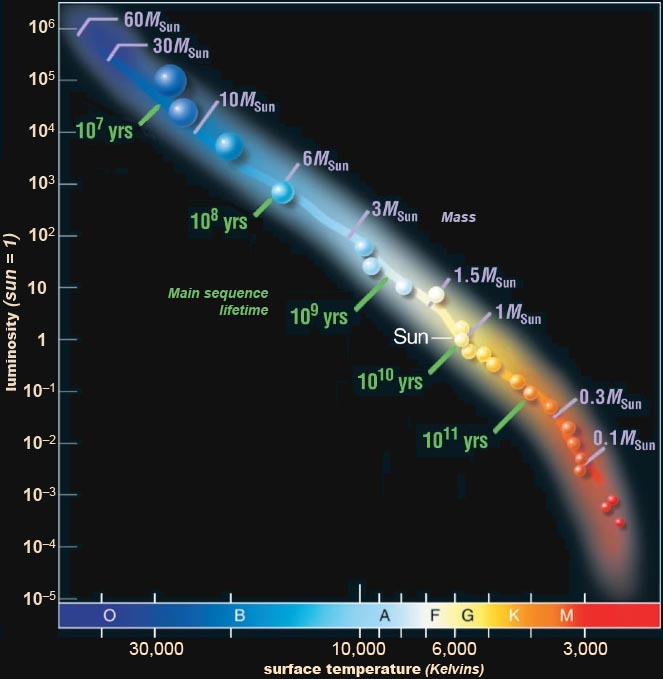
Now you'll see why.
Habitable Zones
A habitable zone is the place where a plane or moon of a planet would be neither too hot nor too cold for life as we know it:
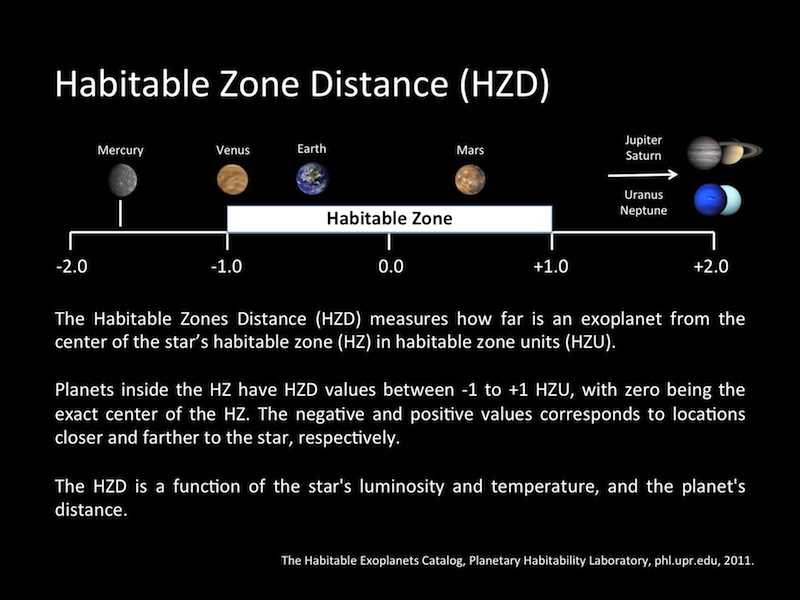
Different classes of stars have different size circumstellar habitable zones (or habitable zones, CHZ or HZ for short),.These habitable zones vary in terms of the distance from their star depending on whether the star is hotter or colder than our Sun. As you can see illustrated here:

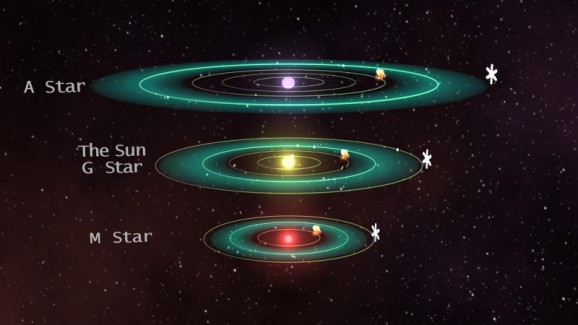
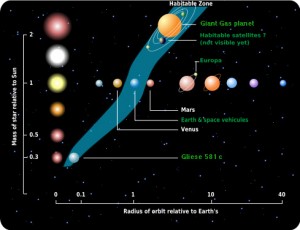
For an explanation of the math that determines this, please go here: albertzotkin.wordpress.com...
Planetary Classification
Just as stars have different classes, so do planets. The Planetary Habitability Laboratory at Arecibo has created classification system for habitable worlds depending on where in their star's habitable zone they exist in. which will be illustrated below:
Habitable worlds like our Earth are called M-Class planets (yep, just like Star Trek!). The M stands for mesoplanet. There are also Class hP and Class P (hypopsychroplanets and psychroplanets) worlds which would be slightly cooler than our Earth and Class T and Class hT (themoplanets and hyperthermoplanets) worlds slightly steamier than the earth.
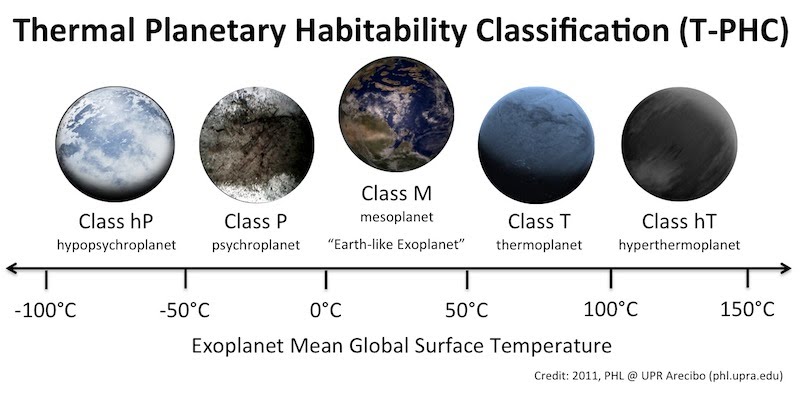
Here's a comparison of some known worlds on the habitable planet classification scale:
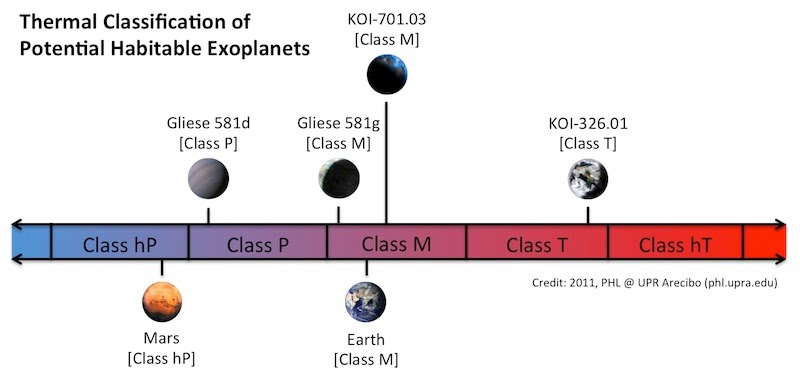
Here are some more nearby worlds which could be more or less like the Earth:
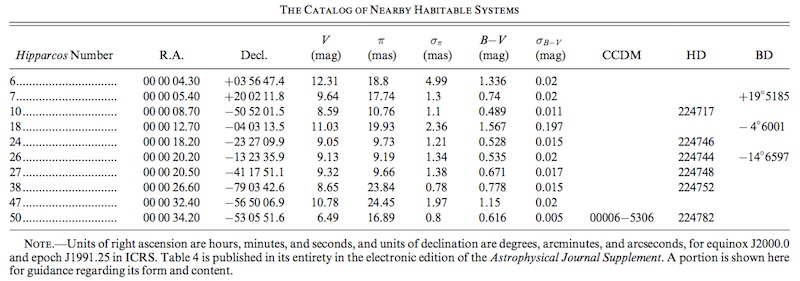
One thing to keep in mind through all this as we look at the Hill-Fish map is the age of the star in which the planets orbit. Life on Earth took 4.5 billion years before we existed to ponder life out there. So planets around stars as old as the sun or older are very interesting because life would presumably have had more time to evolve into intelligent and perhaps technological beings. A star older than our Sun with habitable planets could have technological civilizations not simply 1,000 years or 10,000 or even a million years more advanced but potentially billions of years more advanced than we are.
For these reasons I made the comparison to us being perhaps the baby in the crib inside the house. The answer to the "Fermi Paradox" may not be that we're a zoo, but rather a nursery.
So lets go on to examine each star on the Hill-Fish map individually. I can't do them all in this post but others will follow and eventually I'll have a cool video tour of these stars and some others which lay in direct lines off of the edge of the map from what looks to be the alien "main line". Some of these off-the-map stars are as interesting as ones on it.
I borrowed the formatting from someone named SpookyVince who analyzed the Hill-Fish map in a 2009 post. I left his notes intact in Italicst but added my own after them. It seemed like a good format so why re-invent the wheel? I of course decided to add some helpful information about each start (Class, Age, Distance from the Sun, Distance from Zeta Reticuli. Planets (if available). You will find my updated notes as of 2013 under "Additional Notes:" In some cases I updated the Reference link as well.
Lets start with the star closest to the Earth, the Sun. Why? For comparison's sake it helps to establish a baseline of what we're evaluating. So without further adieu….
Sun
Reference
Class: G2V
Age: 4.5 Billion Years
Distance from Earth: 8 light-minutes
Distance from Zeta Ret: 39.16 light-years
Planets: 8 (4 Terrestrial, 4 Gas Giant)
Companions: (none)
Debris Disk(s): 2 (One 30-50 AU from primary star consisting of icey minor planets beyond outermost Gas Giant Neptune the other between 2-3.3 AU from primary star consisting of rocky minor planets and other debris)
Metallicity: 1.0
The star around which the Earth revolves, and the gravitational center of the Solar System. The Sun is a solitary, yellow dwarf star of spectral type G2 (see G star) that has been on the main sequence for about 4.6 billion years. It will remain a main sequence star for another 5.4 billion years.
Now moving from left to tight on the above map:
Gliese 67 A, B
Reference
Class: G1.5V (For A) M1V (For B) (A is a little hotter than our Sun, B is a LOT cooler than our Sun)
Age: 7 Billion Years
Distance from Earth: 42 light-years
Distance from Zeta Ret: 64.9 light-years
Planets: (none discovered yet)
Companions: Gliese 67 B (between 4.2-10.5 AU in elliptical orbit around A)
Debris Disks: none
Metallicity: A: 1.58 (slightly more metal than our Sun)
Additional notes: Once thought to be a single star, it is now known that Gliese 67 is actually a yellow G-star like our Sun and a smaller M-class red dwarf 30 percent the mass of our Sun. Being a double or binary star does not rule out planets in a habitable zone however:
Recently we've discovered a planet orbiting a similar configuration of stars. It's been referred to in the media as "a real life Tatoine" - www.space.com... - These planets are called circumbinary and they may not be that rare: www.popularmechanics.com...
Also of note is that the Gliese 67 star system was the target of a deliberate attempt to contact extraterrestrial intelligence in 2003 as part of a commercial message sent into space called "Cosmic Call 2" - en.wikipedia.org...
By the time that radio message arrives we will likely have a pretty good idea of what type of planets exist around the system, if any.
Continued in my next post.
So….
Basically earlier in the thread I went into the differences in classes of stars and their life expectancies and evolution:

Now you'll see why.
Habitable Zones
A habitable zone is the place where a plane or moon of a planet would be neither too hot nor too cold for life as we know it:

Different classes of stars have different size circumstellar habitable zones (or habitable zones, CHZ or HZ for short),.These habitable zones vary in terms of the distance from their star depending on whether the star is hotter or colder than our Sun. As you can see illustrated here:



For an explanation of the math that determines this, please go here: albertzotkin.wordpress.com...
Planetary Classification
Just as stars have different classes, so do planets. The Planetary Habitability Laboratory at Arecibo has created classification system for habitable worlds depending on where in their star's habitable zone they exist in. which will be illustrated below:
Habitable worlds like our Earth are called M-Class planets (yep, just like Star Trek!). The M stands for mesoplanet. There are also Class hP and Class P (hypopsychroplanets and psychroplanets) worlds which would be slightly cooler than our Earth and Class T and Class hT (themoplanets and hyperthermoplanets) worlds slightly steamier than the earth.

Here's a comparison of some known worlds on the habitable planet classification scale:

Here are some more nearby worlds which could be more or less like the Earth:

One thing to keep in mind through all this as we look at the Hill-Fish map is the age of the star in which the planets orbit. Life on Earth took 4.5 billion years before we existed to ponder life out there. So planets around stars as old as the sun or older are very interesting because life would presumably have had more time to evolve into intelligent and perhaps technological beings. A star older than our Sun with habitable planets could have technological civilizations not simply 1,000 years or 10,000 or even a million years more advanced but potentially billions of years more advanced than we are.
For these reasons I made the comparison to us being perhaps the baby in the crib inside the house. The answer to the "Fermi Paradox" may not be that we're a zoo, but rather a nursery.
So lets go on to examine each star on the Hill-Fish map individually. I can't do them all in this post but others will follow and eventually I'll have a cool video tour of these stars and some others which lay in direct lines off of the edge of the map from what looks to be the alien "main line". Some of these off-the-map stars are as interesting as ones on it.
I borrowed the formatting from someone named SpookyVince who analyzed the Hill-Fish map in a 2009 post. I left his notes intact in Italicst but added my own after them. It seemed like a good format so why re-invent the wheel? I of course decided to add some helpful information about each start (Class, Age, Distance from the Sun, Distance from Zeta Reticuli. Planets (if available). You will find my updated notes as of 2013 under "Additional Notes:" In some cases I updated the Reference link as well.
Lets start with the star closest to the Earth, the Sun. Why? For comparison's sake it helps to establish a baseline of what we're evaluating. So without further adieu….
Sun
Reference
Class: G2V
Age: 4.5 Billion Years
Distance from Earth: 8 light-minutes
Distance from Zeta Ret: 39.16 light-years
Planets: 8 (4 Terrestrial, 4 Gas Giant)
Companions: (none)
Debris Disk(s): 2 (One 30-50 AU from primary star consisting of icey minor planets beyond outermost Gas Giant Neptune the other between 2-3.3 AU from primary star consisting of rocky minor planets and other debris)
Metallicity: 1.0
The star around which the Earth revolves, and the gravitational center of the Solar System. The Sun is a solitary, yellow dwarf star of spectral type G2 (see G star) that has been on the main sequence for about 4.6 billion years. It will remain a main sequence star for another 5.4 billion years.
Now moving from left to tight on the above map:
Gliese 67 A, B
Reference
Class: G1.5V (For A) M1V (For B) (A is a little hotter than our Sun, B is a LOT cooler than our Sun)
Age: 7 Billion Years
Distance from Earth: 42 light-years
Distance from Zeta Ret: 64.9 light-years
Planets: (none discovered yet)
Companions: Gliese 67 B (between 4.2-10.5 AU in elliptical orbit around A)
Debris Disks: none
Metallicity: A: 1.58 (slightly more metal than our Sun)
2009 Post: A nearby Sun-like star in the constellation Andromeda regarded as a promising candidate for habitability if it possesses any Earth-like planets within its habitable zone. It ranks in the top five stars most likely to support life in a shortlist drawn up in 2006 by astrobiologist Margaret Turnbull, one of the authors of HabCat (Catalog of Nearby Habitable Systems).]/i]
Additional notes: Once thought to be a single star, it is now known that Gliese 67 is actually a yellow G-star like our Sun and a smaller M-class red dwarf 30 percent the mass of our Sun. Being a double or binary star does not rule out planets in a habitable zone however:
The presence of a moderately close companion could disrupt the orbit of a hypothetical planet in HD 10307's habitable zone. However, the uncertainty of the orbital parameters makes it equally uncertain exactly where stable orbits would be in this system.
Recently we've discovered a planet orbiting a similar configuration of stars. It's been referred to in the media as "a real life Tatoine" - www.space.com... - These planets are called circumbinary and they may not be that rare: www.popularmechanics.com...
Also of note is that the Gliese 67 star system was the target of a deliberate attempt to contact extraterrestrial intelligence in 2003 as part of a commercial message sent into space called "Cosmic Call 2" - en.wikipedia.org...
It was transmitted from Eurasia's largest radar, 70-meter Eupatoria Planetary Radar. The message was named Cosmic Call 2, it was sent on July 6, 2003, and it will arrive at HD 10307 in September 2044.
By the time that radio message arrives we will likely have a pretty good idea of what type of planets exist around the system, if any.
Continued in my next post.
edit on 27-10-2013 by JadeStar because: (no reason given)
Tau 1 Eridani
Reference
Class: F7V (A little hotter and more massive than our Sun)
Age: uncertain but thought to be 2.3-3.6 billion years old
Distance from Earth: 46.38 light-years
Distance from Zeta Ret: 32.98 light-years
Planets: (none discovered yet)
Companions: none
Debris Disk: none
Metallicity: 1.04 (about the same as our Sun)
Additional notes: Indeed this is a little studied star. Not much new on it has been published since 2009. No planets have been discovered around it yet but it is likely to be on TESS's (Transiting Exoplanet Satellite) list as well as a few ground based observatory lists. In the late1980s Jill Tarter put the star on the old NASA High Resolution Microwave Survey (HRMS) observation list, NASA's SETI program Here's that list as it was in 1991 shortly before the program was cut in 1994: www.coseti.org...
Tau Ceti
Reference
Class: G8.5V (A little cooler than our Sun)
Age: 5.8 billion years old
Distance from Earth: 11.9 light-years
Distance from Zeta Ret: 32.7 light-years
Planets: 5 Terrestrial (2 habitable: 1 Class M , 1 Class P)
Companions: none
Debris Disks: 1 (10-55 AU from primary star)
Metallicity: 0.55 (metal poor compared to our Sun)
Additional notes: Oh how things change! In 2009 when SpookyVince wrote that we knew of no planets around Tau Ceti. After Tau Ceti's metallicity was revealed to be roughly half of that of our Sun it had been thought by some that Tau Ceti would have no planets. There was a direct correlation between a star's metallicity and it having exoplanets when the first massive "Hot Jupiter" type worlds were first discovered back in the 1990s. Indeed no large jupiter sized planet orbits close to the star, which bodes well for the terrestrial sized planets that are there. If Tau Ceti has any "Gas Giant" planets they are further out than Tau Ceti f. Today in 2013 we know of a whole planetary system consisting of 5 discovered planets (so far). More exciting than just the presence of planets are that two of them are SuperEarths which lay in the Tau Ceti's habitable zone! One of them (Tau Ceti e) has been speculated to be a steamy jungle world while the other (Tau Ceti f) laying on the cold edge of the habitable zone would be more akin to a frozen, Siberia like world (Think Hoth from Star Wars or Delta Vega of Star Trek) .
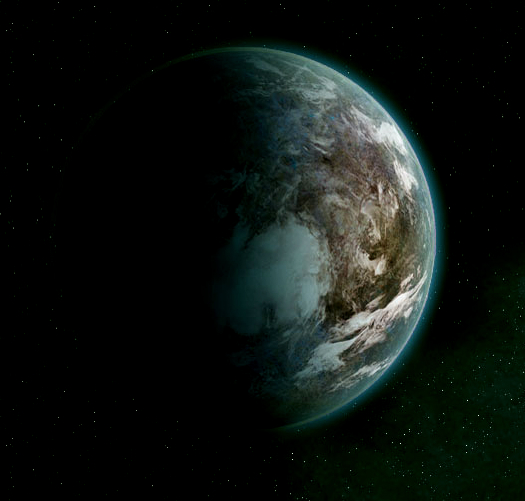
Tau Ceti e

Tau Ceti f
It should be stressed that these are just educated guesses as to what they are probably like based on everything we know about them and what we suspect based on their orbits and amount of sunlight they receive.

Size comparison to our planet:

(Sidenote: It's not hard to imagine beings from either planet being shorter than us due to the higher gravity and perhaps more efficient muscles on lighter weight bodies.)
You can be sure these planets will be highly scrutinized as better instruments come on line. Tau Ceti has been a star system of high interest for a long time. Tau Ceti was was one of the two stars radio astronomer Frank Drake listened for signals from in the first SETI experiment called "Project Ozma". It is also one of the stars in the Habitable Catalog (HabCat) and has been a staple of both radio and optical SETI searches. (I have many of the SETI observing list of stars). In 2004, a team of UK astronomers led by Jane Greaves discovered that Tau Ceti has more than ten times the amount of cometary and asteroidal material orbiting it than does the Sun. White this would seem to spell doom that Tau Ceti e or Tau Ceti f could have time between impacts of asteroids and comets the size of the one which wiped out the dinosaurs that all changes if a large Gas Giant planet is found beyond the orbit of Tau Ceti f. Such a planet would "clean up' much of the debris that would pose a threat to Tau Ceti e or Tau Ceti f much in the same way that Jupiter protects us. There are some early indications that a larger planet or planets may exist outside Tau Ceti f's orbit. If so we'll know in the next 5-10 years.
Continued in my next post...
Reference
Class: F7V (A little hotter and more massive than our Sun)
Age: uncertain but thought to be 2.3-3.6 billion years old
Distance from Earth: 46.38 light-years
Distance from Zeta Ret: 32.98 light-years
Planets: (none discovered yet)
Companions: none
Debris Disk: none
Metallicity: 1.04 (about the same as our Sun)
2009 Post: Not a lot of information found on this star. However, data indicates it is a F5V or F6V star, most likely aged between 4 and 6 billions of years. That is potentially a "sun like" star.
Additional notes: Indeed this is a little studied star. Not much new on it has been published since 2009. No planets have been discovered around it yet but it is likely to be on TESS's (Transiting Exoplanet Satellite) list as well as a few ground based observatory lists. In the late1980s Jill Tarter put the star on the old NASA High Resolution Microwave Survey (HRMS) observation list, NASA's SETI program Here's that list as it was in 1991 shortly before the program was cut in 1994: www.coseti.org...
Tau Ceti
Reference
Class: G8.5V (A little cooler than our Sun)
Age: 5.8 billion years old
Distance from Earth: 11.9 light-years
Distance from Zeta Ret: 32.7 light-years
Planets: 5 Terrestrial (2 habitable: 1 Class M , 1 Class P)
Companions: none
Debris Disks: 1 (10-55 AU from primary star)
Metallicity: 0.55 (metal poor compared to our Sun)
2009 Post: The most Sun-like of the 30 nearest stars to the Sun.
It is not known if the star is accompanied by any planets – its low metallicity makes it questionable whether the nebula from which it condensed had sufficient heavy element content to allow planet-sized objects to form). However, if any planets are present, (...) they are likely to be subjected to a much more intense bombardment than anything the Earth has experienced, making the survival of any life problematic.
Additional notes: Oh how things change! In 2009 when SpookyVince wrote that we knew of no planets around Tau Ceti. After Tau Ceti's metallicity was revealed to be roughly half of that of our Sun it had been thought by some that Tau Ceti would have no planets. There was a direct correlation between a star's metallicity and it having exoplanets when the first massive "Hot Jupiter" type worlds were first discovered back in the 1990s. Indeed no large jupiter sized planet orbits close to the star, which bodes well for the terrestrial sized planets that are there. If Tau Ceti has any "Gas Giant" planets they are further out than Tau Ceti f. Today in 2013 we know of a whole planetary system consisting of 5 discovered planets (so far). More exciting than just the presence of planets are that two of them are SuperEarths which lay in the Tau Ceti's habitable zone! One of them (Tau Ceti e) has been speculated to be a steamy jungle world while the other (Tau Ceti f) laying on the cold edge of the habitable zone would be more akin to a frozen, Siberia like world (Think Hoth from Star Wars or Delta Vega of Star Trek) .

Tau Ceti e

Tau Ceti f
It should be stressed that these are just educated guesses as to what they are probably like based on everything we know about them and what we suspect based on their orbits and amount of sunlight they receive.

Size comparison to our planet:

(Sidenote: It's not hard to imagine beings from either planet being shorter than us due to the higher gravity and perhaps more efficient muscles on lighter weight bodies.)
You can be sure these planets will be highly scrutinized as better instruments come on line. Tau Ceti has been a star system of high interest for a long time. Tau Ceti was was one of the two stars radio astronomer Frank Drake listened for signals from in the first SETI experiment called "Project Ozma". It is also one of the stars in the Habitable Catalog (HabCat) and has been a staple of both radio and optical SETI searches. (I have many of the SETI observing list of stars). In 2004, a team of UK astronomers led by Jane Greaves discovered that Tau Ceti has more than ten times the amount of cometary and asteroidal material orbiting it than does the Sun. White this would seem to spell doom that Tau Ceti e or Tau Ceti f could have time between impacts of asteroids and comets the size of the one which wiped out the dinosaurs that all changes if a large Gas Giant planet is found beyond the orbit of Tau Ceti f. Such a planet would "clean up' much of the debris that would pose a threat to Tau Ceti e or Tau Ceti f much in the same way that Jupiter protects us. There are some early indications that a larger planet or planets may exist outside Tau Ceti f's orbit. If so we'll know in the next 5-10 years.
Continued in my next post...
edit on 27-10-2013 by JadeStar because: (no reason given)
82 Eridani
Reference
Class: G8 V ( A little cooler than our Sun)
Age: Between 6.1-12.7 billion years old
Distance from Earth: 19.7 light-years
Distance from Zeta Ret: 21.61 light-years
Planets: 3 Terrestrial ( 2 Class X, 1 Class T)
Companions: none
Debris Disk: none
Metallicity: 0.44 (metal poor compared to our Sun)
Additional notes: Again, how things change…. When SpookyVince wrote the above 82 Eridani did not have any known planets. We now know of three. From Wikipedia:
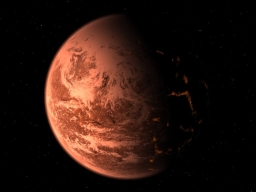
82 Eridani d
There could be a planet in the habitable zone just a little further out than planet d. Time will tell. One thing we won't have to help tell us that are the two missions that were referred to in SpookyVince's 2009 post. Both NASA's Terrestrial Planet Finder was cancelled by the US Congress and NASA. Europe fared no better as the ESA's simpler Darwin spacecraft was mired in the design phase and it was killed in 2009 with no further activities planned. Not only that but NASA's TPF precursor mission the Space Interferometry Mission (SIM) was also cancelled in two different incarnations.
That said, promising ground based telescopes studies and projects are making headway and may be able to get us closer to the goals of the two cancelled projects. 82 Eridani is being highly scrutinized for planets further out.
That's all for now, I'll have another post tomorrow as we walk through our (and perhaps their) corner of the Milky Way Galaxy.
Reference
Class: G8 V ( A little cooler than our Sun)
Age: Between 6.1-12.7 billion years old
Distance from Earth: 19.7 light-years
Distance from Zeta Ret: 21.61 light-years
Planets: 3 Terrestrial ( 2 Class X, 1 Class T)
Companions: none
Debris Disk: none
Metallicity: 0.44 (metal poor compared to our Sun)
2009 Quote No large substellar companion has been found thus far (Murdoch et al, 1993). However, the distance from 82 Eridani A where an Earth-type planet would be "comfortable" with liquid water is centered around 0.80 AU -- midway between the orbital distances of Venus and Earth in the Solar System. At that distance from the star, such a planet would have an orbital period of almost 275 days, or over two thirds of an Earth year. Astronomers are hoping to use NASA's Terrestrial Planet Finder (TPF) and the ESA's Darwin planned groups of observatories to search for a rocky inner planet in the so-called "habitable zone" (HZ) around 82 Eridani. As currently planned, the TPF will include two complementary observatory groups: a visible-light coronagraph to launch around 2014; and a "formation-flying" infrared interferometer to launch before 2020, while Darwin will launch a flotilla of three mid-infrared telescopes and a fourth communications hub beginning in 2015.Furthermore, this star is estimated over 10 billions years old. This leaves a lot of time for any potential life around it to be much more advanced than we are! .
Additional notes: Again, how things change…. When SpookyVince wrote the above 82 Eridani did not have any known planets. We now know of three. From Wikipedia:
On August 17, 2011, European astronomers announced the discovery of three planets orbiting 82 G. Eridani. The mass range of these planets classifies them as super-Earths; objects with only a few times the Earth's mass. These planets were discovered by precise measurements of the radial velocity of the star, with the planets revealing their presence by their gravitational displacement of the star during each orbit. None of the planets display a significant orbital eccentricity. However, their orbital periods are all 90 days or less, indicating that they are orbiting close to the host star. The equilibrium temperature for the most distant planet, based on an assumed Bond albedo of 0.3, would be about 388 K (115 °C); significantly above the boiling point of water.
The number of planets in the system is slightly uncertain. At the time of planet c's detection, it exerted the lowest gravitational perturbation. There was also a similarity noted between its orbital period and the rotational period of the star. For these reasons the discovery team were somewhat more cautious regarding the verity of its candidate planet status than for the other two.Continued observation of the star will be required to determine the exact nature of the planetary system.

82 Eridani d
There could be a planet in the habitable zone just a little further out than planet d. Time will tell. One thing we won't have to help tell us that are the two missions that were referred to in SpookyVince's 2009 post. Both NASA's Terrestrial Planet Finder was cancelled by the US Congress and NASA. Europe fared no better as the ESA's simpler Darwin spacecraft was mired in the design phase and it was killed in 2009 with no further activities planned. Not only that but NASA's TPF precursor mission the Space Interferometry Mission (SIM) was also cancelled in two different incarnations.
That said, promising ground based telescopes studies and projects are making headway and may be able to get us closer to the goals of the two cancelled projects. 82 Eridani is being highly scrutinized for planets further out.
That's all for now, I'll have another post tomorrow as we walk through our (and perhaps their) corner of the Milky Way Galaxy.
edit on
27-10-2013 by JadeStar because: (no reason given)
edit on 27-10-2013 by JadeStar because: (no reason given)
Ross 54
Found this image, which gives an idea of the three dimensional space occupied by the group of stars selected by Marjorie Fish as most closely resembling the Betty Hill star map. www.ufoconspiracy.com/images/zbetty.gif
They seem to have gone a long trip (37 light years), without any stops along the way, to visit Earth. A longer voyage, by far, than to any other single star.
Correct! I was going to point this out later (and I still will) with my theory on why they would have done this. It is rooted soundly in the fact that when they got to Tau Ceti they were likely able to know that either life or, technological life (namely us) was here.
I will spell out just how they would have detected us from Tau Ceti (and no it didn't involve listening for "I Love Lucy") in a later post. Its involves stuff we're just now learning how to do and building instruments sensitive enough for.
Perhaps we should feel flattered.edit on 27-10-2013 by Ross 54 because: added information
I think so. Babies are cute aren't they?
edit on 27-10-2013 by JadeStar because: (no reason given)
new topics
-
In an Historic First, In N Out Burger Permanently Closes a Location
Mainstream News: 1 hours ago -
MH370 Again....
Disaster Conspiracies: 1 hours ago -
Are you ready for the return of Jesus Christ? Have you been cleansed by His blood?
Religion, Faith, And Theology: 4 hours ago -
Chronological time line of open source information
History: 5 hours ago -
A man of the people
Diseases and Pandemics: 6 hours ago -
Ramblings on DNA, blood, and Spirit.
Philosophy and Metaphysics: 7 hours ago -
4 plans of US elites to defeat Russia
New World Order: 8 hours ago
top topics
-
Israeli Missile Strikes in Iran, Explosions in Syria + Iraq
World War Three: 15 hours ago, 17 flags -
In an Historic First, In N Out Burger Permanently Closes a Location
Mainstream News: 1 hours ago, 12 flags -
Thousands Of Young Ukrainian Men Trying To Flee The Country To Avoid Conscription And The War
Other Current Events: 12 hours ago, 7 flags -
Iran launches Retalliation Strike 4.18.24
World War Three: 15 hours ago, 6 flags -
12 jurors selected in Trump criminal trial
US Political Madness: 14 hours ago, 4 flags -
4 plans of US elites to defeat Russia
New World Order: 8 hours ago, 4 flags -
A man of the people
Diseases and Pandemics: 6 hours ago, 4 flags -
Chronological time line of open source information
History: 5 hours ago, 2 flags -
Are you ready for the return of Jesus Christ? Have you been cleansed by His blood?
Religion, Faith, And Theology: 4 hours ago, 2 flags -
MH370 Again....
Disaster Conspiracies: 1 hours ago, 1 flags
active topics
-
In an Historic First, In N Out Burger Permanently Closes a Location
Mainstream News • 4 • : 38181 -
12 jurors selected in Trump criminal trial
US Political Madness • 49 • : iaylyan -
4 plans of US elites to defeat Russia
New World Order • 32 • : Oldcarpy2 -
Thousands Of Young Ukrainian Men Trying To Flee The Country To Avoid Conscription And The War
Other Current Events • 22 • : Xtrozero -
Fossils in Greece Suggest Human Ancestors Evolved in Europe, Not Africa
Origins and Creationism • 69 • : Xtrozero -
George Knapp AMA on DI
Area 51 and other Facilities • 24 • : Raptured -
Marjorie Taylor Greene Files Motion to Vacate Speaker Mike Johnson
US Political Madness • 63 • : WeMustCare -
Do we live in a simulation similar to The Matrix 1999?
ATS Skunk Works • 23 • : JoelSnape -
Are you ready for the return of Jesus Christ? Have you been cleansed by His blood?
Religion, Faith, And Theology • 13 • : Cvastar -
MH370 Again....
Disaster Conspiracies • 4 • : Vermilion
